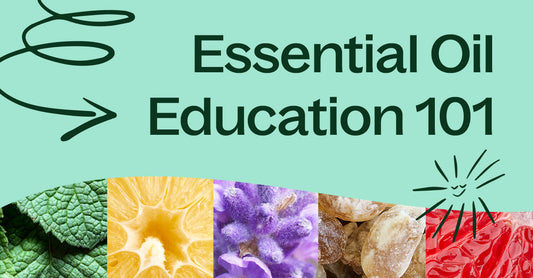By: Ellen Brenner, Certified Aromatherapist
To recap from Food for Thought (Part I), we said thoughts are things. We discussed how negative thoughts and emotions can be toxic to our health through a neurochemical connection between our mind and body.
Here, we are going to talk about how we can make our thoughts more nourishing to our wellbeing.
Very simply, we have power to rewire the message playing in our heads. And, wait until you see how aromatherapy is perfectly suited to support this!
Our brains have this very cool feature called neuroplasticity. We used to think our brains were hardwired in childhood and unchanging after that. But, in the mid-1960’s, scientist found that the brain is actually very pliable and adaptable. In fact, it is constantly reorganizing itself and creating new messaging pathways based upon stimulation from our environment, and our thoughts and behaviors, over the course of our entire lifetime.
What this means is we can choose to change the unhealthy patterns from the negative thoughts and emotions that can become conditioned over time. When we turn off these patterns, we turn off the spigot of neurochemicals that is stressing our systems.
Okay, are you ready for some simple solutions? Here is our version of a Triple A map for this part of our journey: affirmations, anchors and aromatherapy.
Affirmations
Affirmations are simply a positive thought used to replace a negative thought. They help to create new patterns and focus the mind on something we wish to create for ourselves. Repeated enough times, the mind begins to accept it and adapts. So, hold that positive thought. We are going to come back to it in a moment.
Anchors
One of the most fundamental ways we learn is through a process called associative learning. This is when a response is learned through stimulation to our senses from an external cue. For example, when I smell cookies, I feel hungry. When this association becomes connected to a mood, behavior or feeling, it is called an anchor. When I smell cookies, I have very happy memories of baking with my Grandma.
Research into how scent acts as an anchor has been prolific since the 1980’s, including how these anchors can influence mood when inhaled again later, even at the smallest levels. A positive anchor used over and again, can help establish new connections and patterns in the brain more quickly and help us to readily remember what we learned . Because scent acts as such a strong anchor, investigators are studying how to use this in therapy .
Aromatherapy
Smell is the only sense directly connected to the brain. When we inhale, scent molecules go immediately from our nose to our brain through a specialized nerve pathway without passing go.
Here is the really cool part!
Scent travels to the very same part of the brain – the limbic system — where emotions, behaviors, mood, and memory are processed and stored.
Whe n I smell, or even think of the smell, of Play-Doh, the memory file drawer just springs open and wonderful childhood scenes start playing like moving images in my brain.
n I smell, or even think of the smell, of Play-Doh, the memory file drawer just springs open and wonderful childhood scenes start playing like moving images in my brain.
This is also the same part of the brain where the nervous and endocrine (hormone) systems are regulated to let our bodies know if we are relaxed and happy, or unhappy and stressed. And, scientists believe the limbic system is also where associative learning takes place. Pretty, cool, huh?
Ok, so what does this all mean and how do we use it?
It is really super simple!
We are going to use aromatherapy to create new positive thoughts about ourselves. This will allow our minds and bodies to bring themselves back into a healthier state of balance and wellbeing. And, this is something you can do for yourself on-the-go, as needed, and in private.
Are you ready?
1) Determine an affirmation that works for you.
It would be something easily remembered. It needs to be a positive statement in the present tense. And, it is used to replace a negative thought and repeated as needed.
For example: “I am smart and confident.”
2) Choose a scent, or a blend of a few scents, from your essential oils.
Sometimes, just keeping it simple is best so the brain can associate it as an anchor.
Here are some possibilities to get you started. But, don’t over think it. Just reach for something that appeals to you and puts you in a positive place.
- Calming — Lavender, Neroli, Chamomile Roman, Spearmint
- Balancing – Bergamot, Frankincense, Lavender, Lemon
- Uplifting — Lemon, Lime, Grapefruit, Orange
- Quieting – frankincense, Basil linalool, Sandalwood
- Invigorating – Black Pepper, Peppermint, Rosemary
3) Choose something to hold your scent so that it can be easily portable and within reach. Some options might be:
- personal inhaler
- aromatherapy jewelry
- cotton ball in a Ziploc bag
4) Notice when you have a negative thought without judgment.
For example: “I am stupid”, or, “I have a stupid question.”
5) Inhale your chosen scent as you repeat your affirmation to yourself.
For example: Inhale bergamot as you tell yourself “I am smart and confident.”
6) Repeat as often as needed.
Eventually, it becomes easier to think more positive thoughts and to discard negative thoughts as they appear. And, we are able to more readily access this positive place we have created for ourselves.
By creating a happier outlook in the way we think about ourselves, we can support a healthier state of our own overall wellbeing .
For me, sandalwood + bergamot and an affirmation of “All is well” immediately transports me to the “Life is Good” place! I hope this discussion of essential wellbeing helps you find yours!
Resources:
- Brain Topography, 2011, Volume 24, Number 3-4, Page 302
Pascual-Leone A., Freitas C., Oberman L., Horvath J. C., Halko M., Eldaief M.; et al. (2011). “Characterizing brain cortical plasticity and network dynamics across the age-span in health and disease with TMS-EEG and TMS-fMRI”. Brain Topography 24: 302–315. doi:10.1007/s10548-011-0196-8 - Kirk-Smith MD, Toller C, Dodd GH. Unconscious odour conditioning in human subjects. Biol Psychol. 1983;17:221–231.
- Tisserand, Robert. “Three Things That Happen in the Brain When You Inhale Essential Oils.” How Essential Oils Work In the Body Mini- Course.” Tisserand Institute. Online video clip. YouTube. February 29, 2016. Web. March,19, 2016.
- Hay, Louise L. You Can Heal Your Life. United States: Hay House, Inc. 1999. Print.
- Cohen, Geoffrey L an d Sherman, David K. “The Psychology of Change: Self-Affirmation and Social Psychological Intervention.” Annu. Rev. Psychol. 2014. 65:333–71. Web. April 20, 2016. https://ed.stanford.edu/sites/default/files/annurev-psych-psychology_of_change_final_e2.pdf










